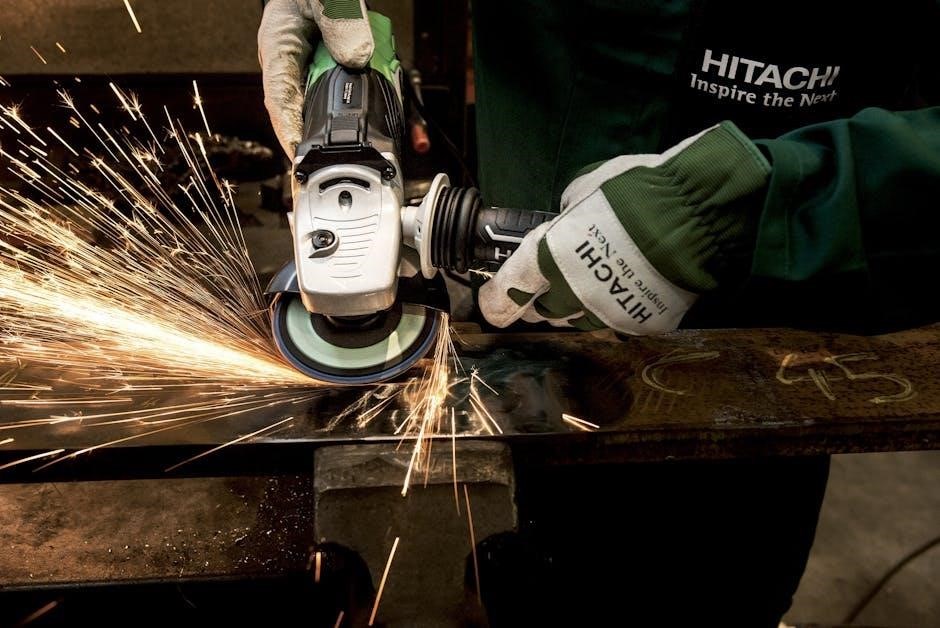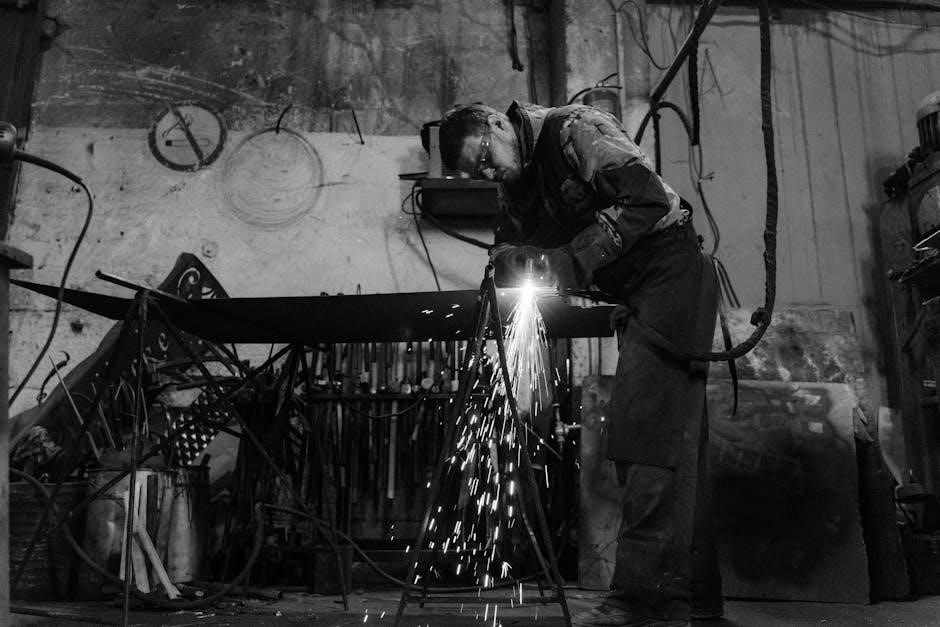
The 15th Edition Steel Construction Manual, released in 2017, is a comprehensive resource for structural steel design, replacing the 14th Edition. It includes updated standards like ANSI/AISC 360-16 and expanded design tables for modern steel construction practices.
Historical Background and Significance
The 15th Edition Steel Construction Manual marks a milestone in the evolution of structural steel design, first published in 1927. It has served as a cornerstone for engineers, architects, and constructors, providing essential design guidance. The manual’s historical significance lies in its continuous updates, reflecting advancements in steel technology and design practices. Its release in 2017 continues a legacy of trusted resources, ensuring compliance with modern standards and practices in the steel construction industry.
Purpose and Scope of the Manual
The 15th Edition Steel Construction Manual serves as a primary reference for designing steel structures, providing detailed specifications, design aids, and best practices. Its scope encompasses a wide range of structural steel applications, from beams and columns to connections and joints. The manual is tailored for engineers, architects, and fabricators, offering practical guidance to ensure safe, efficient, and economical steel construction. It includes updated design criteria and standards, making it an indispensable resource for the industry.

Key Standards and Specifications Included
The 15th Edition Steel Construction Manual includes key standards such as ANSI/AISC 360-16, 2014 RCSC Specification, and ANSI/AISC 303-16 for structural steel design and construction practices.
ANSI/AISC 360-16: Specification for Structural Steel Buildings
The ANSI/AISC 360-16 specification, included in the 15th Edition Steel Construction Manual, provides updated design criteria for structural steel buildings. It covers materials, fabrication, and erection, ensuring safety and efficiency. This standard is a cornerstone for engineers, addressing flexural, compression, and tension member design. It aligns with the 2014 RCSC and AISC 303-16 standards, offering a comprehensive framework for modern steel construction practices and advancements in structural engineering.
2014 RCSC Specification for Structural Joints Using High-Strength Bolts
The 2014 RCSC Specification provides detailed criteria for the design, installation, and inspection of structural joints using high-strength bolts. Included in the 15th Edition Steel Construction Manual, it addresses bolted connection behavior, preload requirements, and tightening procedures. This specification ensures reliability and safety in steel construction, complementing the ANSI/AISC 360-16 standard. It offers guidance on prequalified connectors and torque-based tensioning, enhancing efficiency for engineers and fabricators in modern structural steel projects.
ANSI/AISC 303-16: Code of Standard Practice for Steel Buildings and Bridges
The ANSI/AISC 303-16 standard outlines common practices for steel buildings and bridges, fostering collaboration between fabricators, engineers, and contractors. Included in the 15th Edition Steel Construction Manual, it addresses fabrication, erection, and quality control. This code establishes guidelines for tolerances, corrective measures, and documentation, ensuring consistency and clarity in construction practices. It complements other specifications like ANSI/AISC 360-16, providing a comprehensive framework for modern steel construction projects.
Major Features and Updates in the 15th Edition
The 15th Edition introduces new design tables, expanded HSS tables for higher-strength steel, and updated design criteria, enhancing efficiency in modern steel construction practices.
New Design Tables and Aids
The 15th Edition features extensive new design tables and aids, including W-shape column tables for 65- and 70-ksi steel, and updated HSS design tables for higher-strength ASTM A500 Grade C steel. A new Super Table combines W-shapes, HSS, and pipe sections, streamlining design workflows. Additionally, a new Znet table for coped beams enhances design accuracy. These resources provide engineers with efficient tools for modern steel construction, ensuring compliance with the latest standards and materials.
Updated Design Criteria for Structural Steel
The 15th Edition introduces updated design criteria aligned with the latest research and industry practices. It incorporates the 2016 AISC Specification for Structural Steel Buildings (ANSI/AISC 360-16) and the 2014 RCSC Specification for Structural Joints. These updates reflect advancements in material strength, connection design, and load calculations. Engineers now have access to refined methodologies for determining structural steel member capacities, ensuring safer and more efficient designs. The manual also addresses emerging trends in high-strength steel applications, enhancing its relevance to modern construction challenges.
Expanded HSS Design Tables for Higher Strength ASTM A500 Grade C Steel
The 15th Edition includes expanded design tables for Hollow Structural Sections (HSS), specifically addressing higher strength ASTM A500 Grade C steel. These updates enhance design flexibility by providing detailed properties and capacities for HSS members. Engineers can now efficiently utilize HSS in demanding applications, benefiting from improved material strength and structural efficiency. The expanded tables align with modern construction trends, offering comprehensive solutions for complex steel framing systems and load-bearing applications.

Design Examples and Practical Applications
The manual includes two volumes of design examples and practical tools, aiding engineers in applying steel design principles effectively. Volume 1 focuses on structural steel buildings, while Volume 2 provides tables and aids for efficient construction, ensuring real-world application of the updated criteria and standards.
Volume 1: Design Examples for Structural Steel Buildings
Volume 1 provides detailed design examples for structural steel buildings, illustrating the application of the 2016 AISC specifications. It covers beams, columns, connections, and more. These examples guide engineers through practical design scenarios, emphasizing compliance with updated standards. The volume is structured for clarity, making complex concepts accessible. It serves as a valuable resource for both students and professionals, offering insights into modern steel construction practices and their real-world application.
Volume 2: Tables and Design Aids for Efficient Construction
Volume 2 offers extensive tables and design aids to streamline the construction process. It includes updated HSS design tables for higher strength ASTM A500 Grade C steel, as well as W-shape column tables for 65- and 70-ksi steel. These resources enhance efficiency and accuracy in structural steel design. The volume also provides new design criteria and aids, such as coped beam strength design procedures, ensuring compliance with the latest standards and practices in modern steel construction.

Updates from the 14th Edition
The 15th Edition introduces expanded HSS design tables for higher strength ASTM A500 Grade C steel and W-shape column tables for 65- and 70-ksi steel. Updated coped beam design procedures and new standards like ANSI/AISC 360-16 are also included, enhancing design accuracy and efficiency compared to the 14th Edition.
Revisions in Design Procedures for Coped Beams
The 15th Edition introduces revised design procedures for coped beams, enhancing accuracy and efficiency. Key updates include new Znet tables for coped W-shapes, updated formulas, and clarified design limits. These revisions align with current research and industry practices, providing engineers with improved tools for analyzing and designing coped beams. The updates ensure safer and more reliable structural steel designs, addressing gaps in previous editions and incorporating feedback from practitioners. This reflects AISC’s commitment to advancing steel construction standards.
Inclusion of W-Shape Column Tables for 65- and 70-ksi Steel
The 15th Edition now includes W-shape column tables for 65- and 70-ksi steel, addressing the demand for high-strength materials in modern construction. These tables provide essential design data, enabling engineers to efficiently specify and analyze columns using higher strength steels. This addition enhances design flexibility and cost-effectiveness, catering to advanced structural requirements. The updated tables align with ASTM standards and reflect industry trends toward stronger, lighter steel sections, making the manual a vital resource for contemporary steel construction projects.

Availability and Access
The 15th Edition Steel Construction Manual is available in both hard copy and digital formats. The hard copy is a durable blue vinyl-bound book, while the digital edition offers convenient online access through subscription options. Members and non-members can purchase copies, with pricing varying based on membership status.
Hard Copy and Digital Editions
The 15th Edition Steel Construction Manual is available in both hard copy and digital formats. The hard copy is a durable, blue vinyl-bound book containing over 2,300 pages of structural steel design information. It features thumb cuts for easy navigation through its 18 major sections. The digital edition provides online access, allowing users to efficiently search and reference content. Both formats ensure accessibility for engineers, architects, and professionals in the field of steel construction, with pricing varying for AISC members and non-members.
Subscription Options for Online Access
The 15th Edition Steel Construction Manual offers flexible subscription options for digital access. Users can purchase an annual online subscription, priced at $175 for AISC members and $350 for non-members. This provides convenient access to the manual’s content, enabling efficient searching and referencing. The digital format ensures professionals can access critical design information anytime, making it an essential resource for structural engineers and architects working with steel construction projects. Subscriptions can be purchased directly through the AISC website.

Companion Resources
The v15.1 Companion to the AISC Steel Construction Manual provides supplementary tools and updated design examples, split into two volumes for enhanced usability and reference.
v15.1 Companion to the AISC Steel Construction Manual
The v15.1 Companion enhances the 15th Edition Manual with supplementary tools and design aids. It includes updated design examples and tables, now divided into two volumes for clarity. Volume 1 focuses on detailed design examples, while Volume 2 offers practical tables and aids. This resource aligns with the 2016 AISC Specification, ensuring engineers and architects have comprehensive support for modern steel construction projects. It serves as an essential supplement for both academic and professional use.
Supplementary Tools for Advanced Design and Analysis
The 15th Edition Manual is complemented by advanced supplementary tools, including updated design examples and tables. These resources provide detailed guidance for complex structural steel elements, such as HSS design tables for higher strength ASTM A500 Grade C steel. Engineers can utilize these tools for precise calculations and analysis, ensuring compliance with modern standards. Additionally, digital aids like spreadsheets and design software are available, enhancing efficiency in steel construction projects. These tools cater to both theoretical and practical applications, supporting innovative design solutions.
Applications in Modern Steel Construction
The 15th Edition Manual supports modern steel construction through updated design criteria and tools, enhancing efficiency and safety in high-rise buildings, bridges, and complex structural projects.
Use in Structural Engineering and Architecture
The 15th Edition Manual serves as a cornerstone for structural engineers and architects, offering detailed design criteria, tables, and standards for steel construction projects. It aids in creating efficient, safe, and innovative structures by providing updated specifications for beams, columns, and connections. Architects utilize the manual to integrate structural elements seamlessly into building designs, ensuring both functionality and aesthetic appeal. This resource is essential for professionals aiming to meet modern construction demands and deliver high-performance steel structures.
Adoption in Academic and Professional Training
The 15th Edition Steel Construction Manual is widely adopted in academic programs and professional training for its comprehensive coverage of structural steel design. Universities incorporate it into engineering curricula to teach students about modern steel construction practices. Professional training programs also rely on the manual to educate engineers and architects on updated standards and design criteria. Its detailed examples and clear explanations make it an indispensable resource for both education and ongoing professional development in the field.

Future of Steel Construction Manuals
The 15th Edition sets the stage for future manuals, with a focus on digital integration, updated standards, and emerging technologies to enhance structural steel design and construction practices.
Anticipated Updates and Improvements
Future editions of the Steel Construction Manual are expected to incorporate advancements in structural steel design, including new technologies and sustainability practices. Updates may focus on expanding design tables for high-strength materials and improving digital tools for easier access and application. The integration of AI-driven design aids and 3D modeling capabilities could enhance user efficiency. Additionally, there may be a stronger emphasis on energy-efficient construction and environmentally friendly steel solutions to align with global sustainability goals.
Role of Digital Platforms in Manual Development
Digital platforms have revolutionized the development and accessibility of the Steel Construction Manual. Online editions allow real-time updates, ensuring users access the latest standards and design criteria. Interactive tools, such as design calculators and 3D modeling software, enhance user experience. Digital subscriptions offer flexibility, enabling engineers to reference the manual across devices. These platforms also facilitate collaboration, with features for sharing and annotating content, making them indispensable for modern structural steel design and construction projects.